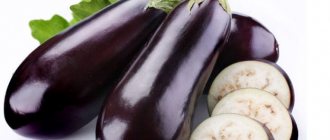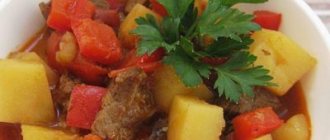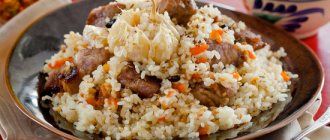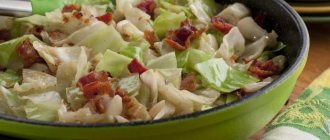Taking into account the calorie content of vegetables in proper nutrition (+ table)
Proper nutrition requires that at least a third of the daily menu should consist of vegetables.
When creating a menu, it is recommended to take into account the calorie content of vegetables, so as not to violate the basic rule of healthy eating - the amount of energy consumed should not exceed its consumption. Consumption of vegetables can ensure replenishment of essential vitamins and minerals without harming your figure. In addition to the fact that vegetables give you a feeling of fullness, they help to reduce weight if the ratio of different types is correctly selected, taking into account their calorie content. The nutritional value is different in raw and thermally processed foods. Our nature gives us an abundance of different vegetables. When it comes to the benefits of eating them because they are low in calories, this is, to put it mildly, a rough generalization.
Vegetable calorie table
| View | Kcal per 100 g | View | Kcal per 100 g |
| Avocado | 169 | Ground cucumbers | 14 |
| Eggplant | 24 | Greenhouse cucumbers | 11 |
| Beet tops | 17 | Bulgarian pepper | 27 |
| Green peas | 73 | Parsley greens | 49 |
| Zucchini | 23 | Parsley root | 38 |
| White cabbage | 27 | Radish | 21 |
| Kohlrabi cabbage | 42 | Radish | 35 |
| Cabbage | 16 | Salad | 17 |
| Cauliflower | 30 | Head lettuce | 11 |
| Brussels sprouts | 37 | Beet | 42 |
| Red cabbage | 27 | Celery root | 32 |
| Potato | 80 | Tomatoes | 23 |
| Corn on the cob | 110 | Pumpkin | 25 |
| Green onion feather | 19 | Dill | 32 |
| Green onion | 29 | Horseradish | 44 |
| Leek | 33 | Garlic | 46 |
| Bulb onions | 41 | Spinach | 16 |
| Carrot | 37 | Sorrel | 46 |
You can find values for many vegetables in calorie tables. To make it easier to navigate the choice, they are divided into groups:
The group of tuberous plants includes potatoes and Jerusalem artichokes. The usual potato is the “second” bread. Its nutritional value is 70 kcal (per hundred grams), so its amount should be reduced by those who are trying to lose weight. Jerusalem artichoke is lower in calories than potatoes. Its energy value is 62 kcal.
Root vegetables include the following:
- beet;
- carrot;
- radish;
- radish;
- roots of celery, parsley, parsnip.
These affordable foods are low in nutritional value and contain many vitamins and minerals. Of this group, the lowest calorie content is in radishes - 20 kcal, turnips (32), carrots (35), beets (42) and parsley roots (51).
The fruit group is the largest, it includes tomatoes, eggplants, peppers, pumpkins, and cucumbers. Tomatoes and cucumbers have the lowest calorie content of 16 and 14 kcal, zucchini and eggplant - 23 and 26 kcal, peppers and pumpkin - 26 and 22 kcal. All types of cabbage, from white cabbage to broccoli, are famous for their low calorie content - from 30 to 35 kcal.
Legumes have the highest calorie content. For example, the nutritional value of beans is 298 kcal. But since legumes are considered meat substitutes in terms of protein, they can be safely consumed in small quantities by anyone who is concerned about their weight.
Let's talk separately about how the calorie content of vegetables changes in raw and stewed form. Stewed foods are lower in calories than raw foods if a minimum of fat is used in their preparation. It is ideal to steam vegetables, which preserves vitamins and reduces calorie content.
When consuming them, it is necessary to take into account the needs and characteristics of the body.
Cocktails and smoothies
Cocktails, sweetened specialty coffee drinks, teas and soda are the biggest enemies of healthy eating, especially when it's hot outside. But they can be replaced with more useful solutions.
There is a certain risk here, we must give the body a lot of fluid, especially in the hot season, but fluids quench thirst and do not affect the feeling of hunger. Many people are sure that there are no calories in drinks. This is a gross violation. After all, manufacturers often add huge doses of sugar to make the drink more attractive, so it is best to prepare the drink at home. You can make ginger iced tea or lemon water. These drinks do not spoil so quickly and will perfectly quench your thirst even in the midst of summer.
Many people complain that vegetable calorie tables constantly remind them of the weight loss process. But don’t despair, because a beautiful figure is worth it.
Steamed vegetables
Ingredients: eggplant, celery, onion, carrots, parsley, chili pepper, thyme, sea salt, ground paprika, olive oil Calories/100g: 69.47
You can simply prepare a delicious and super healthy salad from vegetables for dinner. Vegetables for it are steamed, and the finished dish is served warm. See recipe for full details.
For the recipe you will need: – one or two eggplants; – 200 g celery; – a head of onion; – two carrots; – a bunch of parsley; – a pod of chili pepper; – a pinch of thyme; – sea salt – to taste; – a pinch of ground paprika; – olive oil – 1/2 teaspoon.
Ingredients: zucchini, chicken meat, onion, chicken egg, white bread, salt, spices Calories/100g: 96.88
These pancakes can be prepared for lunch or dinner, which, by the way, would be the best option for a child or an adult. The dish is light and not overloaded with fats. Be sure to take note of the recipe.
For the recipe you will need: - zucchini - 250 g, - chicken fillet - 350 g, - onion, - one egg, - two slices of white bread, - 10 g of salt, - 5 g of spices.
Ingredients: trout, potatoes, garlic, sea salt, spices, onions, parsley Calories/100g: 82.61
We suggest preparing a very tasty dish for lunch or dinner - steamed trout with potatoes in a slow cooker. It's fast, simple, satisfying and beautiful.
Ingredients: – 2 fresh trout steaks, – 2 cloves of garlic, – 4 potato tubers, – 2 bunches of parsley, – spices – 5 g, – sea salt to taste, – 1 onion.
Ingredients: chicken, potatoes, pumpkin, dried bell pepper mixture, Italian herb mixture, granulated garlic, ground paprika, nutmeg, bay leaf, peppercorn mixture, salt Calories/100g: 134
To many, food cooked in a double boiler seems bland and boring. But this is far from true. Steamed food can and should be cooked in a delicious and varied way. The main thing is to be able to combine ingredients correctly and choose the right recipes.
Ingredients: – 1 kg chicken; – 400 g potatoes; – 300 g pumpkin; – 3 tbsp. l. mixtures of dried sweet peppers; – 1 tbsp. mixtures of Italian herbs; – 1 tsp. granulated garlic; – 1 tsp. ground paprika; – 1 tsp. ground nutmeg; – 2 bay leaves; – a mixture of peppercorns; - salt.
Ingredients: marcurus, savoy cabbage, potatoes, onions, garlic, olive oil, yogurt, green onions, ground red pepper Calories/100g: 64.32
Macrurus is a fish that is held in high esteem by nutritionists because it has a low calorie content. It is also not difficult to prepare. The best heat treatment method for this type of fish is steaming. Try cooking grenadier according to our new recipe.
For the recipe you will need: – 400 g of fish; – 200 g savoy cabbage; – 200 g potatoes; – 80 g onions; – 2 cloves of garlic; – 1 teaspoon of olive oil; – 2 tbsp. spoons of yogurt; – a small bunch of green onions; – ground red pepper – a pinch.
Ingredients: cod, cauliflower, salt, ground black pepper, dry white wine, cream, butter, tomato Calories/100g: 119.32
Steamed cod is a tasty, light and healthy dish. While cooking fish, all its nutritional properties are preserved. Recommended for the whole family.
For the dish you will need: – cod – 2 steaks; – cauliflower – 300 g; – salt – to taste; – ground black pepper – to taste. For the sauce: – a third of a glass of dry white wine; – half a glass of heavy cream; – 1 tbsp. spoon of butter; – one large tomato; – a third of a teaspoon of salt; – a third of a teaspoon of ground pepper.
Ingredients: Potatoes, Beetroot, Onion, Tomato, Eggplant, Cabbage Calories/100g: 37.86
In a double boiler you get the most wholesome and healthy food, which, moreover, contains a minimum amount of calories. Therefore, vegetable stew in a double boiler will fit perfectly into your diet menu!
- 2 pcs. potatoes; – 1 beet; – 1 onion; – 1 tomato; – 1 eggplant; - half a head of cabbage.
Product categories
Dairy products and eggs Cheese, Ice cream, Milk, Eggs, Yogurt, Milkshake, Sour cream, Butter, Kefir, Buttermilk, Eggnog, Low cheese...
Spices and herbs
Pepper, Chili, Dill, Turmeric, Rosemary, Basil, Cinnamon, Coriander, Seasoning mixture, Dried dill spice, Mint, Tim...
Baby food
Pretzels, Bottle feeding powder, Liquid bottle feeding, Baby food, Vegetable…
Fats and oils
Butter, Mayonnaise, Margarine, Fat, Sandwich spread, Creamy dressing, Butter substitute, Fish oil, Animal fat, Lard…
Poultry and poultry products
Chicken, Turkey, Goose, Ostrich, Pheasant, Quail, Emu, Guinea Fowl, Pigeon, Raw Chicken, Chicken Breast, Chicken Wings, …

Soups and sauces
Sauces, Soups, Gravy, Broth, Liquid sauces, Thick soups, Wasabi, Vegetable soup, Chicken soup, Beef soup, Tomato…
Sausages
Ham, Sausage, Salami, Bolnja, Pastrama, Frankfurter sausage, Polish sausage, Bratwurst, Spreads, Pepperoni, Pash...
Fruits and juices
Juices, Apples, Pears, Cherries, Smoothies, Melon, Blueberries, Peaches, Apricots, Grapefruit, Prunes, Plums, Figs, Pineapple, Plan...
Meat
Pork, Beef, Bacon, Veal, Lamb, Bison, Rabbit, Venison, Beefalo meat, Caribou meat, Goat meat, Antelope, K…
Nuts and seeds
Seeds, Walnuts, Chestnut, Coconut, Cashew Nut, Almonds, Sesame Seeds, Ginkgo Nut, Pistachios, Cotton Seed Kernels...
Beverages
Tea, Coffee, Wine, Juice drinks, Beer, Gin, Vodka, Energy drinks, Whiskey, Almond milk, Lemonade, Coke…
Fish and seafood
Shrimp, Crabs, Catfish, Perch, Clam, Butterfish, Whitefish, Carp, Anchovy, Octopus, Crayfish, Bluefish, …
Beans
Peas, Lentils, Soybeans, Okara, Soy Cheese, Cooked Beans, Pinto Beans, Kidney Beans, Green Beans, Green Beans...
Bread and pastries
Bread, Bagels, Waffles, Cookies, Toasted Bread, Cinnamon Bread, Blueberry Waffles, White Bread, Hamburger, Brown Bread...
Candies and sweets
Syrups, Sugar, Sweets, Jams, Jelly candies, Topping, Confectionery coating, Chewing marmalade, Grated chocolate…
Cereals and pasta
Millet, Oats, Barley, Pasta, Buckwheat, Bulgur, Amaranth grains, Couscous, Pasta, Corn bran, Corn flour, …
Other
Cereals, Sea Lion Meat, Wheat Flakes, Agave, Steelhead, Prickly Pear, Elk Meat, Ringed Seal, Zap…
home kitchen
Cheesecakes, Chicken cutlets with semolina, meat solyanka, Homemade ham, Fried potatoes with onions, Mushroom soup, …
Calorie counter
Calorie content of vegetables
Wanting to get rid of excess weight, we, one way or another, approach the issue of a balanced diet. How to supply the body with the necessary substances and satisfy the feeling of hunger without harming your figure? The best way out in this situation would be to enrich your diet with vegetables, the calorie content of which is so low that many do not even waste time counting it .
In addition, British scientists were able to establish that the more vegetables a person eats, the more satisfied he is with life. Do you want to be slim and happy? Then regularly use a variety of vegetables in your menu, and the result will not take long to arrive. Very soon you will feel that your health has improved, and your body has begun to lose excess weight.
Why are vegetables good for weight loss?
The presence of vegetables on the table of a person losing weight is mandatory, although they themselves do not burn fat, but:
- supply the human body with vitamins, beneficial microelements, fiber;
- allow you to achieve a feeling of satiety;
- They have such a low calorie content that they can be consumed without fear of harming your figure.
Very often, by torturing themselves with all kinds of diets, people cause irreparable harm to their health, depriving the body of substances necessary for normal functioning. If you eat right, consuming a large amount of vegetables, which contain few calories and a huge amount of useful elements, the need for a diet will disappear by itself.
How many calories are in vegetables?
A wonderful summer time is coming, which will give us a great opportunity to enrich our diet with healthy vegetables. You can buy them in a store, enjoying the affordable price and excellent quality, or you can grow them in your own garden, enjoying the results of your own labor. The most important thing is that there is such a variety of all kinds of vegetable crops that you can prepare a new dish every day without ever repeating it.
Of course, the calorie content of vegetables will differ . The number of calories in vegetables containing starch (potatoes and legumes) will be higher than in “watery” vegetables (tomatoes, cucumbers, etc.). Therefore, their consumption should be limited, for example, you can replace high-calorie dishes with such products (pasta, pastries, fatty meats).
There are so many vegetable crops that it is not possible to consider the calorie content of each of them; for this, there are special tables that will help those for whom scrupulous calorie counting is necessary. We will consider the calorie content of vegetables, the most accessible and often used in the menu of a modern person.
- Potatoes are considered the most high-calorie plant; the calorie content of the vegetable is about 70 kcal, due to the starch it contains. Therefore, if you are aiming to lose weight, it is better to reduce your potato consumption;
- Carrots are a crop rich in fiber, vitamins A and B, iron, it is very nutritious and healthy, and most importantly, the calorie content of the vegetable is only 32 kcal ;
- Broccoli is a real storehouse of useful vitamins and microelements; it helps speed up metabolic processes and normalize digestive activity. How many calories are in a vegetable? Only 28 kcal per 100 g!
- Spinach, containing calcium, iron and copper, as well as a large amount of vitamins, can satisfy your hunger without the slightest harm to your figure, because the calorie content of the vegetable is only 22 kcal.
- The appetizing aroma of pumpkin and its fresh taste make this product very popular among those who want to lose weight; the calorie content of the vegetable is 21 kcal per 100 g;
- Few people will eat onions as an independent dish, but adding them as a seasoning can add a piquant taste to even the most bland food. The calorie content of the vegetable is 38 kcal per 100 g.
- Juicy and tasty tomatoes can delight you in almost unlimited quantities, because the number of calories in a vegetable is only 14-19 kcal per 100 g ;
- Cucumbers, which have a diuretic effect, can rid the body of excess moisture and saturate it with vitamins and beneficial microelements, while the calorie content of the vegetable is only 10-15 kcal;
- White cabbage is an integral product of a healthy diet, which helps normalize intestinal activity and the digestive system as a whole. The vegetable contains 28 kcal per 100 g.
Negative calorie content of vegetables is a concept that is of great importance for those who want to lose weight . This means that there is a group of vegetables for the processing of which the body spends more calories than the crop itself contains. You don’t even have to count how many calories are in vegetables, since almost all of them have negative calories.
Energy value of vegetables
The top non-calorie vegetables include: broccoli, carrots, radishes, tomatoes, zucchini. But the undisputed leaders remain Chinese cabbage and cucumbers. Beijing cabbage, in addition to its low-calorie content (13 kcal per 100 g of fruit), is also a real treasure trove of vitamins and the essential amino acid lysine. It helps cleanse the blood and reduces the risk of progressive atherosclerosis. Cucumbers, in turn, contain 14 kcal per 100 g of product and are rich in potassium, iodine, vitamins and folic acid. This entire complex has an extremely positive effect on the enzymatic function of the thyroid gland, the functioning of the gastrointestinal tract and the nervous system.
Canned and pickled vegetables
All canned foods are extremely high in calories. The maximum nutritional value of olives is 175 kcal/100 g. Next is caviar from zucchini or eggplant, 121 and 149 kcal, olives - 117 kcal and tomato paste - 102.
Green peas contain much fewer kilocalories - 41 kcal, spinach and green beans - 18 kcal.
Among pickled vegetables, beets deserve the “calorie” championship - 35 kcal, followed by carrots - 24 and white cabbage - 23. Calorie pickled fruits are crowned with sweet red peppers - 23 kcal, and in last place are tomatoes and cucumbers - from 13 to 18 calories.
Important!
Pickled and pickled vegetables are healthier than canned ones, but they are also higher in calories.
| Product | Kilocalories (kcal) |
| Radish | 18 |
| Tomatoes | 22 |
| Zucchini | 26 |
| Broccoli | 32 |
| Carrot | 34 |
| Swede | 38 |
| Eggplant | 23 |
| Green pea | 70 |
| White cabbage | 29 |
| Red cabbage | 32 |
| Cauliflower | 29 |
| Potato | 84 |
| Green onions | 22 |
| Bulb onions | 44 |
| Ground cucumbers | 15 |
| Greenhouse cucumbers | 10 |
| Green pepper | 21 |
| Red pepper | 28 |
| Radish | 35 |
| Turnip | 27 |
| Salad | 13 |
| Green bean | 32 |
| Horseradish | 72 |
| Cheremsha | 34 |
| Garlic | 107 |
| Spinach | 21 |
| Sorrel | 29 |
| Jerusalem artichoke | 61 |
| Artichoke | 29 |
| Gherkin | 30 |
| Pumpkin | 22,5 |
| Squash | 20 |
| Chinese cabbage | 13 |
| Beans | 58 |
| White beans | 102 |
| Red beans | 92 |
| Lentils (sprouts) | 118 |
| Corn on the cob | 115 |
| Soybeans (sprouts) | 145 |
Calorie content of vegetable salads for weight loss
Of course, most vegetables are tasty on their own, but you always want to diversify the menu with unusual dishes that are healthy for your figure. The easiest way to prepare vegetables is to make a salad that combines the beneficial properties of its ingredients.
The calorie content of a vegetable salad for weight loss is calculated by summing the number of calories of each product included . As an example, let me offer you a recipe for a delicious and healthy salad.
Vegetable salad “Breath of Summer”
- Tomato – 100 g (16 kcal);
- Cucumber – 100 g (15 kcal);
- Parsley – 10 g (4.7 kcal);
- Bell pepper – 50 g (13.5 kcal);
- Olive oil – 5 g (44.9 kcal);
- Salt – 2 g (0 kcal).
The total weight of the salad is 267 g, the total number of calories is 94.1 kcal, that is, the calorie content of such a salad per 100 g will be 35.3 kcal. Thus, the low calorie content of vegetable salad allows you to use such a dish for the benefit of the body and without harm to the figure.
Vegetables on the grill
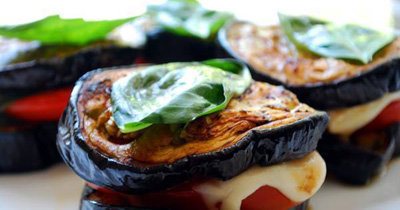
- After cooking you will receive 4 servings
- Cooking time: 30 minutes
During barbecue season, vegetables, meat and fish are welcome “guests” on the grill! We cook vegetables on the grill and use the vegetables to make a sandwich!
This dish is suitable for vegetarians and it is gluten free! Besides, it’s delicious and healthy!
Products for 4 servings
1. Vegetable oil Eggplant: 8 eggplant rings 1.3-1.5 cm thick Mozzarella: 4 mozzarella cheese rings 0.6-0.8 mm thick
2. 2 tablespoons olive oil 1.5 tablespoons balsamic vinegar 1 clove garlic 4 bunches arugula 2 large tomatoes 3 tablespoons chopped basil leaves 2 tablespoons pine nuts3.
salt and pepper to taste
Vegetables on the grill. Cooking
1. Eggplant
First, wash the vegetables and wipe dry. Cut the eggplants into rings. Grease well with vegetable oil.
Add salt and pepper to taste.
Prepare the grill/grill to medium temperature.
Fry eggplant slices on both sides on a grill
- cooking lasts about 10 minutes.
2. Sandwich
Place a slice of cheese on 4 eggplant slices. Cover the cheese with the remaining eggplant slices.
Place on grill grate and bake for about 2 minutes.
- the cheese will “flow.”
Of course, this sandwich can be complemented with tomatoes, pickled onions, avocado slices, baked bell peppers or tomato sauce!
3. Salad
Peel the garlic and finely chop. Cut the tomatoes into pieces. Remove the leaves from the basil sprigs and chop.
Wash the arugula, dry and sort.
Place food in a jar with a lid
- - vegetable oil
- - vinegar
- - salt
- - pepper
Close the lid.
Shake well until the dressing is smooth.
Place arugula, tomatoes and basil in one salad bowl and pour over the dressing.
4. Feed
Lightly fry the pine nuts without fat.
Divide the salad into 4 servings and place on serving plates. Place 1 sandwich on the salad.
Sprinkle the dish with nuts.
Grilled vegetables are the perfect dish for your figure!
Contains few calories and minimal fat!
The nutritional value:
- Calories: 202 kcal
- Fat: 14 g
- Carbohydrates: Almost no carbs!
Bon appetit!
Source: https://pitanie-pri.ru/recepty/ovoshhi-na-mangale.html
Calorie content of stewed and steamed vegetables
Vegetables are most useful in their raw form, because after undergoing heat treatment, they lose a large amount of vitamins and nutrients. However, stewed and steamed vegetables are very popular among those who want to get rid of extra pounds. And although the calorie content of such dishes is slightly higher, they are still rightfully considered dietary.
In order to reduce the calorie content of stewed vegetables, you should not add oil to the dish, which increases its calorie content by about 130 kcal. To improve the taste and increase the nutritional value of plants prepared in this way, you can sometimes add beef or mushrooms, but you should not do this often. The calorie content of stewed vegetables with the addition of meat will increase by 138 kcal, and mushrooms by 40-50.
Steamed vegetables are an excellent low-calorie dish. Thanks to steam treatment, you can preserve most of the vitamins and nutrients contained in vegetables, and the low calorie content of such a dish will help satisfy your hunger without adding a single gram to your weight.
As you can see, a variety of vegetable dishes can enrich your body with all the necessary vitamins and microelements. By eating healthy and low-calorie foods, you can save yourself from having to go on a strict diet, which can never guarantee either health safety or final weight loss.
Calorie content of fresh vegetables
The calorie content of vegetables is important to know for overweight people who want to lose weight. The caloric intake of the diet is calculated taking into account all the components of the diet. Calories in vegetables are most often calculated per 100 g of food weight. Now you can find different versions of online calculators that allow you to calculate the required daily calorie intake depending on gender, initial and desired weight, type of activity and age, as well as find out how many calories are in the vegetables of a particular dish.
It is known that plant foods are lower in calories compared to animal products. This makes vegetables a valuable dietary product. Individual vegetable crops can be combined in a variety of ways, which allows vegetable salads for weight loss to become a dish that diversifies your daily diet.
Some examples of calorie content of fresh vegetables (kcal per 100 g of product):
- Eggplant – 24;
- Green peas – 72;
- White cabbage – 28;
- Potatoes – 83;
- Onions – 43;
- Carrots – 33;
- Cucumbers – 10;
- Sweet pepper – 27;
- Parsley – 45;
- Radish – 20;
- Tomatoes – 15;
- Salad – 14;
- Green beans – 32;
- Garlic – 106.
The calorie content of vegetables can sometimes be quite high, these primarily include legumes (peas, beans, beans) and starch-rich vegetables (for example, potatoes). They can be included in the diet only periodically, replacing other high-calorie dishes with them. Watery vegetables are the lowest in calories (for example, cucumbers, tomatoes) and are recommended to be consumed daily. Vegetable salads for weight loss, among other things, are valuable for the structured water they contain.
It is important to remember that the calorie content of a vegetable salad is affected by what it is seasoned with. Mayonnaise, full-fat sour cream or sauce significantly increase the calorie content of vegetables, so people on a diet are best seasoned with vegetable oil (sunflower, olive, etc.) or, even better, lemon juice.
Table of caloric content of vegetables and fruits in descending order, complete list
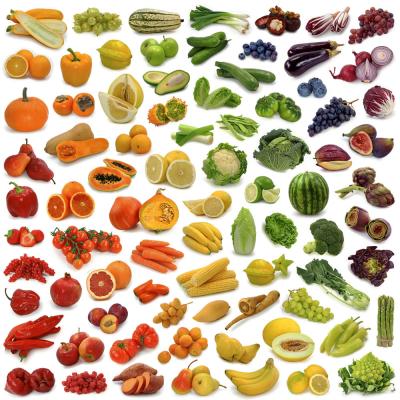
Fresh fruits, vegetables and herbs – these foods top the food list of most diets. They are rich in vitamins, microelements and fiber. Contains a minimum of calories. It would seem that you can eat as much as you want and lose weight. But it's not that simple.
Fresh fruits, vegetables and greens top the food list of most diets. They are rich in vitamins, microelements and fiber, while containing a minimum of calories. But it's not that simple.
Is low calorie content the most important indicator?
The dietary menu has its own nuances. Important indicators are the glycemic index (GI) and glycemic load (GL). They show how quickly carbohydrates are broken down and absorbed by the body. The lower the GI and GL, the fewer calories will be stored as extra pounds.
If we talk about vegetables, then among them you can find real enemies of a thin waist, for example, potatoes. And almost all fruits can surprise you with their sky-high sugar levels, since they all contain a fast source of carbohydrates - fructose.
There are two more factors that negate the benefits of fruits and vegetables:
The rate of energy breakdown from carbohydrates after heat treatment increases significantly
The fact is that fiber is destroyed during cooking. Carbohydrates turn from complex to simple. And in order to process vegetables raw, the body spends more energy and, accordingly, calories.
Tip : It is better to eat vegetables raw. They completely retain vitamins and slowly saturate the body. The smaller you cut vegetables or fruits, the faster they are absorbed by the body.
When crushed, fiber, which slows down the breakdown of carbohydrates, is destroyed. This is especially true for making juices and smoothies. Some vegetables and almost all fruits become the worst enemies for health and figure.
Tip : Before eating, eat vegetables and fruits whole or cut into large pieces.
Calorie content of vegetables and greens
Vegetables and greens are not harmful to your figure. Carrots are considered the healthiest for girls. It makes our skin beautiful. Tomatoes are perfect for men in this regard. They care about men's health.
But still, you should know how many calories are hidden in vegetables. After all, potatoes contain a large number of calories and have a high glycemic index, which increases greatly when cooked. Therefore, it cannot be classified as a useful product.

You can include greens and other vegetables in your diet in almost unlimited quantities. The table below will help you count calories. It also contains information about BZHU, GI and GN products.
All data is indicated for products in their raw form and without taking into account heat treatment, which significantly increases GI. Those. Boiled carrots will have a GI much higher than fresh ones.
Table of calorie content of vegetables and herbs per 100 grams
| Vegetables and greens | GI | GN | B | AND | U | Kcal |
| Artichokes | 20 | 1,2 | 1 | 6 | 28 | |
| Eggplant | 20 | 1,1 | 1 | 7 | 24 | |
| Broccoli | 15 | 0,7 | 4 | 2 | 5 | 33 |
| Ginger | 15 | 2,1 | 2 | 1 | 16 | 80 |
| Zucchini | 15 | 0,8 | 1 | 5 | 19 | |
| White cabbage | 15 | 0,6 | 2 | 5 | 28 | |
| Brussels sprouts | 15 | 0,9 | 5 | 8 | 43 | |
| Cauliflower | 15 | 0,6 | 2 | 5 | 28 | |
| Cabbage | 15 | 0,4 | 1 | 3 | 16 | |
| Potatoes (boiled) | 65 | 10,9 | 2 | 18 | 80 | |
| Corn (boiled) | 70 | 15,7 | 4 | 2 | 24 | 123 |
| Green onion | 15 | 1,1 | 1 | 5 | 19 | |
| Bulb onions | 15 | 1,4 | 1 | 10 | 41 | |
| Olives | 15 | 0,8 | 2 | 16 | 5 | 166 |
| Fresh carrots | 30 | 1,8 | 1 | 4 | 33 | |
| Cucumber | 15 | 0,3 | 1 | 2 | 15 | |
| Olives | 15 | 0,9 | 1 | 11 | 6 | 115 |
| Sweet pepper | 15 | 0,8 | 1 | 6 | 27 | |
| Chilli | 15 | 1,2 | 2 | 10 | 40 | |
| Parsley | 5 | 0,4 | 4 | 8 | 45 | |
| Tomatoes | 30 | 1,3 | 1 | 4 | 23 | |
| Radish | 15 | 0,5 | 1 | 3 | 20 | |
| Leaf lettuce | 10 | 0,3 | 1 | 2 | 14 | |
| Beet | 30 | 2,7 | 2 | 9 | 40 | |
| Celery | 15 | 0,3 | 1 | 2 | 12 | |
| Asparagus | 15 | 0,6 | 2 | 3 | 20 | |
| Pumpkin | 65 | 3,4 | 1 | 8 | 29 | |
| Dill | 5 | 0,4 | 2 | 6 | 38 | |
| Zucchini | 15 | 0,8 | 2 | 2 | 17 | |
| Garlic | 30 | 9 | 6 | 30 | 146 | |
| Spinach | 15 | 0,4 | 3 | 2 | 22 |
Grilled vegetables
A great alternative to heavy kebabs. A plate of grilled vegetables is a must-have on any table in the summer. You can diversify it, try grilling onions, bell peppers, zucchini, carrots, eggplants, asparagus and garlic. You can use them to prepare the following dishes:
- Grilled vegetables with spinach and goat cheese.
- Grilled vegetable flatbreads.
- Grilled vegetables with ricotta and fresh herbs.
- Warm grilled vegetable salad.
The table of caloric content of vegetables is not at all important here, because this method of preparation contains a minimum of fat, and all the beneficial properties of the products are preserved.
Calorie content of fruits and berries
It has been proven that the denser the consistency of the fruit pulp, the more calories it contains. For comparison, you can take watermelon and banana. It's easy to guess that a banana has more calories than a watermelon.
It is also easy to determine the number of harmful kilojoules in a product by taste. The riper and sweeter the fruit, the more sugar and calories it contains. Therefore, choose fruits that are slightly unripe - they have less sugar and more fiber.

Eat fruits and berries. But no more than 2 pieces or 2 cups per day, respectively. Choose fruits that are not too sweet and have thin flesh. And don't forget to count your calories using the table below.
Calorie table for fruits and berries per 100 grams
| Fruits and berries | GI | GN | B | AND | U | Kcal |
| Apricot | 35 | 2,5 | 1 | 11 | 46 | |
| Avocado | 10 | 0,2 | 2 | 20 | 7 | 208 |
| Cherry plum | 25 | 1,6 | 8 | 34 | ||
| A pineapple | 50 | 7 | 11 | 49 | ||
| Orange | 30 | 3 | 1 | 8 | 36 | |
| Watermelon | 75 | 6,6 | 8 | 27 | ||
| Banana | 55 | 11 | 2 | 22 | 89 | |
| Cowberry | 35 | 2,9 | 1 | 8 | 43 | |
| Grape | 45 | 6,8 | 1 | 17 | 65 | |
| Cherry | 25 | 2,8 | 1 | 12 | 52 | |
| Pomegranate | 33 | 6,5 | 1 | 14 | 52 | |
| Grapefruit | 25 | 2,4 | 1 | 10 | 29 | |
| Pear | 30 | 4 | 11 | 42 | ||
| Melon | 65 | 4 | 7 | 38 | ||
| Figs | 35 | 6,9 | 1 | 14 | 49 | |
| Kiwi | 50 | 5,5 | 1 | 10 | 48 | |
| Strawberry wild-strawberry | 25 | 2 | 1 | 7 | 30 | |
| Cranberry | 45 | 3,1 | 4 | 28 | ||
| Coconut | 45 | 2,8 | 3 | 34 | 30 | 380 |
| Gooseberry | 25 | 4 | 1 | 12 | 43 | |
| Lemon | 20 | 20,6 | 1 | 3 | 16 | |
| Raspberries, blackberries | 25 | 2,9 | 1 | 11 | 42 | |
| Mandarin | 30 | 3 | 1 | 8 | 33 | |
| Mango | 50 | 7 | 12 | 67 | ||
| Nectarine | 35 | 3 | 1 | 12 | 48 | |
| Peach | 35 | 3,2 | 1 | 11 | 46 | |
| Plum | 30 | 2,4 | 1 | 10 | 42 | |
| Red currants | 25 | 1,9 | 1 | 8 | 39 | |
| Black currant | 15 | 1,1 | 1 | 7 | 36 | |
| Persimmon | 50 | 8 | 17 | 53 | ||
| Blueberry | 25 | 6 | 1 | 11 | 44 | |
| Apple | 35 | 4 | 10 | 47 |
The table shows that watermelon per 100 grams has a very high glycemic index ( 75 ). Is this product really worth avoiding due to its high GI? Considering that watermelon is almost entirely water, it has a low glycemic load ( 6.6 ). Therefore, in small quantities, watermelon will not harm your figure. But if you are used to eating half a watermelon at a time, then keep in mind that 500 grams of this product will cause a load equal to 33 .
As you can see, calorie content is far from the main indicator. The glycemic index and glycemic load show much more accurately how healthy a product will be. Use the above tables of caloric content of vegetables and fruits, and you will always correctly plan your daily menu.
Summer products
To easily cut calories in your summer diet, you need to add summer foods to it. It's quite simple. Seasonal produce appears in abundance at markets and local grocery stores. In addition to making low-calorie meals, they're packed with vitamins, minerals, antioxidants, and fiber. But do not forget that some vegetables and fruits are higher in calories than others.

Based on calorie counting, we can conclude that the most high-calorie foods are avocados, potatoes, and, most surprisingly, grapes. And no matter how great the temptation is to pamper yourself with juicy bunches, if you want to look perfect in a few weeks, you need to keep this representative of hot regions off your table.
Leave oranges and apples for autumn, let your body get the maximum benefit from fresh berries, melons, and herbs. In addition to well-known products, you can try overseas delicacies such as zucchini, daikon, and lychee. The list of products from which you can choose is simply huge. All these super nutritious and low calorie fruits, greens and vegetables are growing in the garden this time of year.
Next, you will be presented with a table of calorie content of vegetables per 100 grams of product.
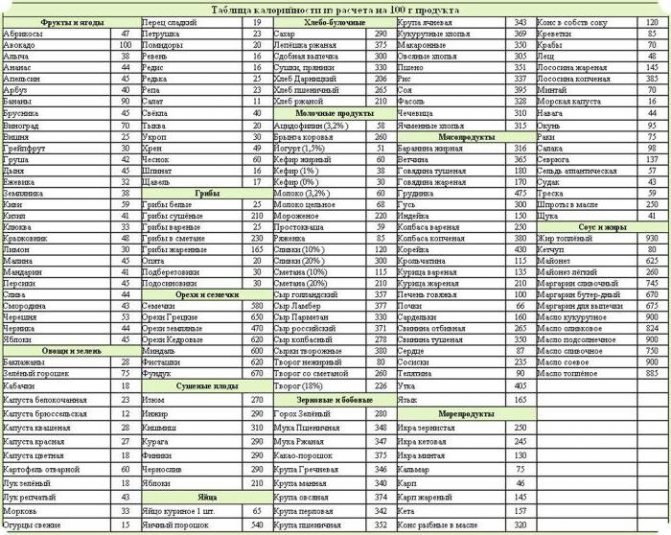
Separately, it is worth noting that the calorie content of boiled vegetables differs from the data in the table with fresh foods. After all, during cooking, the chemical and molecular composition of products changes. The table of caloric content of boiled vegetables can become a visual aid not only for those who want to lose weight, but also for connoisseurs of tasty and healthy food.
Among the leaders in summer weight loss products, cold soups occupy a well-deserved place. These are low-calorie foods that not only quench thirst, but also saturate the body with useful elements. Here everyone can choose what they like: beetroot soup, okroshka, gazpacho, cucumber soup - just listen to what your body wants more right now. The calorie table for fresh vegetables is a great option to choose those foods that will not harm your body.
Brief summary of recommendations
In order to successfully and correctly count calories in borscht, soups, casseroles and other dishes, you will need the following: kitchen scales, calorie tables, calculator, notepad and pen.
It is best to choose electronic scales This way you will know the exact weight. It's easy to test the scale before purchasing: take a small object (or several objects) whose weight you know and place it on the scale several times. Reboot the scale and test again. If the number does not change, the scales are not lying. Many manufacturers allow an error of +/- 5 grams. Tables of weights and measures for determining the weight of food are not helpful here: after cooking, you will need to weigh the dish in order to calculate its total calorie content, and then your one serving.
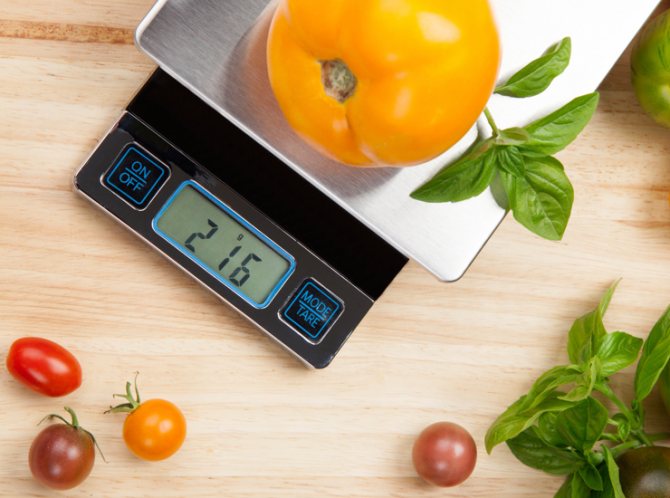
A collection of calorie tables can be found in any bookstore, and you will always have it at hand. The calorie content of the product is also indicated on the packaging. The numbers may vary slightly in different tables. Choose one table for yourself and use only that one.
all kitchen utensils in advance, so that later you can easily subtract the weight of the dishes or plates.
When preparing dishes, it is important to remember: the calorie content of water and salt is 0 (zero) kcal. But water adds weight and thereby changes the overall calorie content of the dish.
The more water you add, the more weight and the fewer calories per 100 grams
A dish that you have counted once does not need to be counted unless its composition changes. Just write down the quantities of ingredients you need in your notebook.
And most importantly, the formula for calculating the calorie content in 100 grams of a finished dish:
A grams = B kcal
100 grams = X kcal
How to understand the symbols in this formula?
• A (grams) – total weight of the finished dish in grams;
• B (kcal) – total calorie content of food in the finished dish.
How to use this formula?
We multiply the two numbers diagonally by each other and divide by the number that is diagonally with X:
B × 100: A = the number of calories in 100 g of the dish you prepared.
Is the formula not very clear? Let's look at detailed examples of how to apply it in practice.
Simple dishes: porridge
Let's start with a simple dish and calculate the calorie content of ordinary rice porridge.
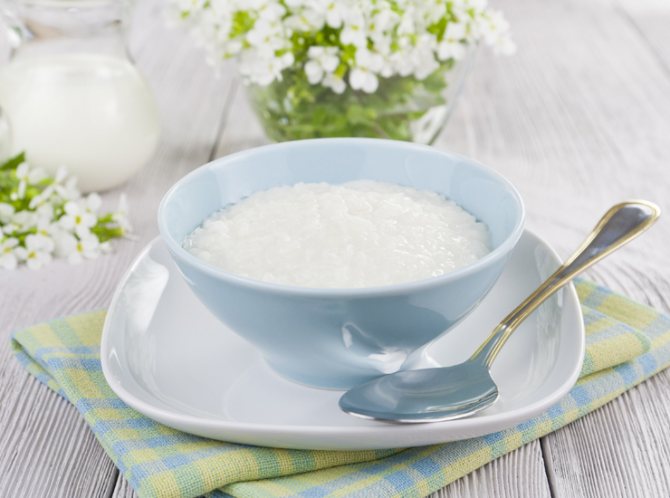
Ingredients: • Rice – 300 g • Water • Salt
1. 100 grams of dry rice contains 330 kcal. 2. For our porridge, we took 300 g of cereal: 330 kcal × 3 = 990 kcal. 3. The entire volume of cooked rice porridge will have a calorie content of 990 kcal : except for water and salt, which, as we already know, have no calories, we did not add anything else. 4. From 300 g of dry rice you get about 900 g of ready-made porridge . 5. Using the formula, we calculate the calorie content of rice porridge per 100 grams:
900 g rice porridge = 990 kcal
100 g rice porridge = X kcal
990 × 100: 900 = 110 kcal (990 multiplied by 100 and divided by 900)
So, our result: 100 grams of rice porridge contains 110 kcal.
Using a similar scheme, we calculate the calorie content of boiled pasta, beans, and lentils. Before cooking, weigh the dry pasta and calculate the calorie content of the dry weight. Boil the pasta, drain the water and weigh the finished pasta: the weight will be greater because the pasta has absorbed water. Then we calculate the calorie content per 100 g.>
How many calories are in broth and compote?
When cooking, part of the calories is transferred from the food to the broth: from fish - 15%, from meat - 20%, fruit - 30%, dumplings, manti and khinkali - 20%. These numbers may fluctuate: it all depends on the cooking time of the products.
Let's calculate the calorie content of salmon fish broth. Take a salmon steak weighing 300 g and 1 liter of water. Calorie content of salmon in 100 g = 142 kcal, in 300 g of this fish = 426 kcal (142 × 3).
426 kcal – 15% = 63.9 kcal (rounded to 64 kcal).
1 liter of salmon broth contains 64 kcal . 100 ml of broth contains only 6.4 kcal!
